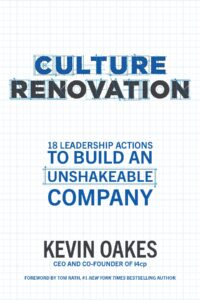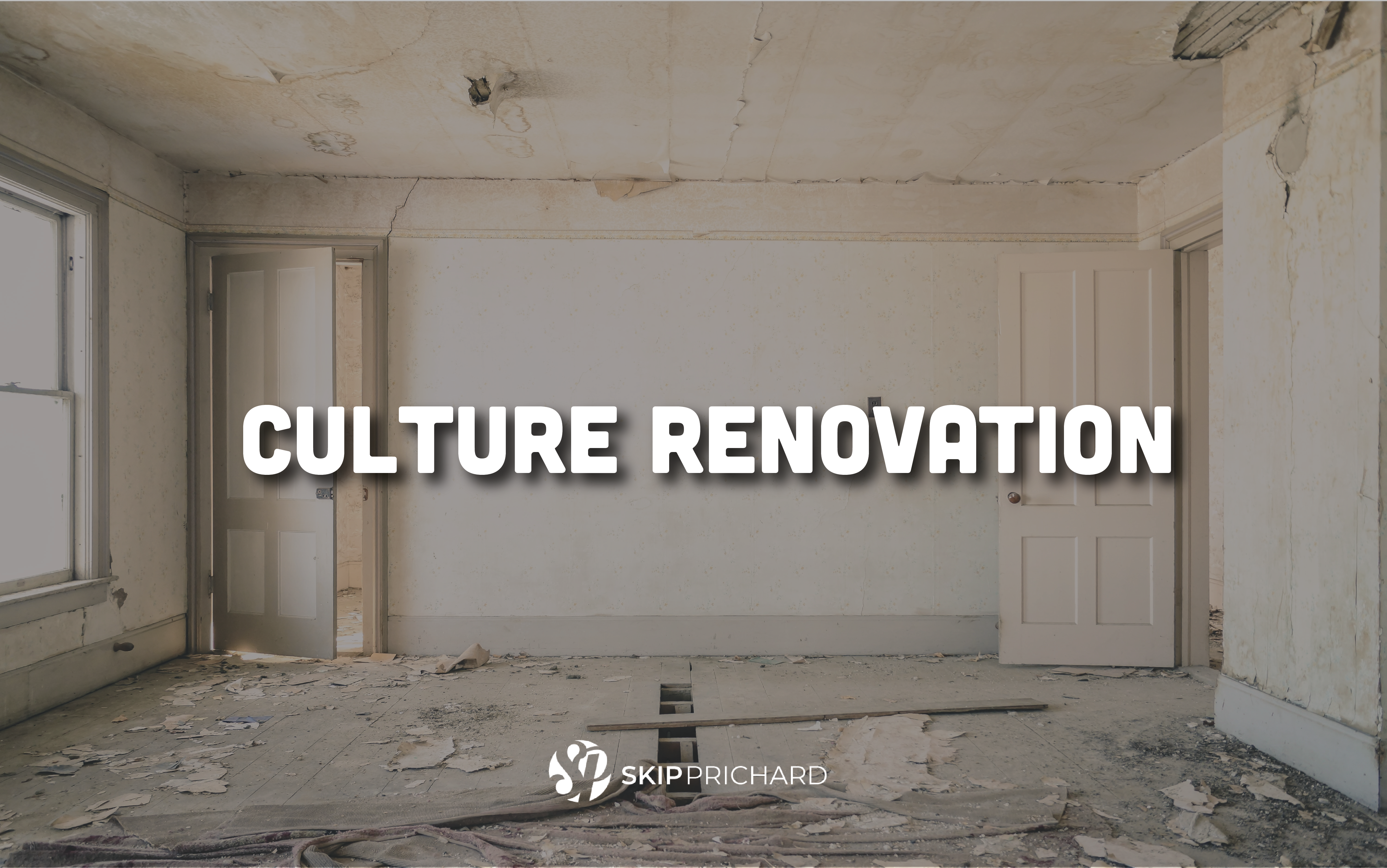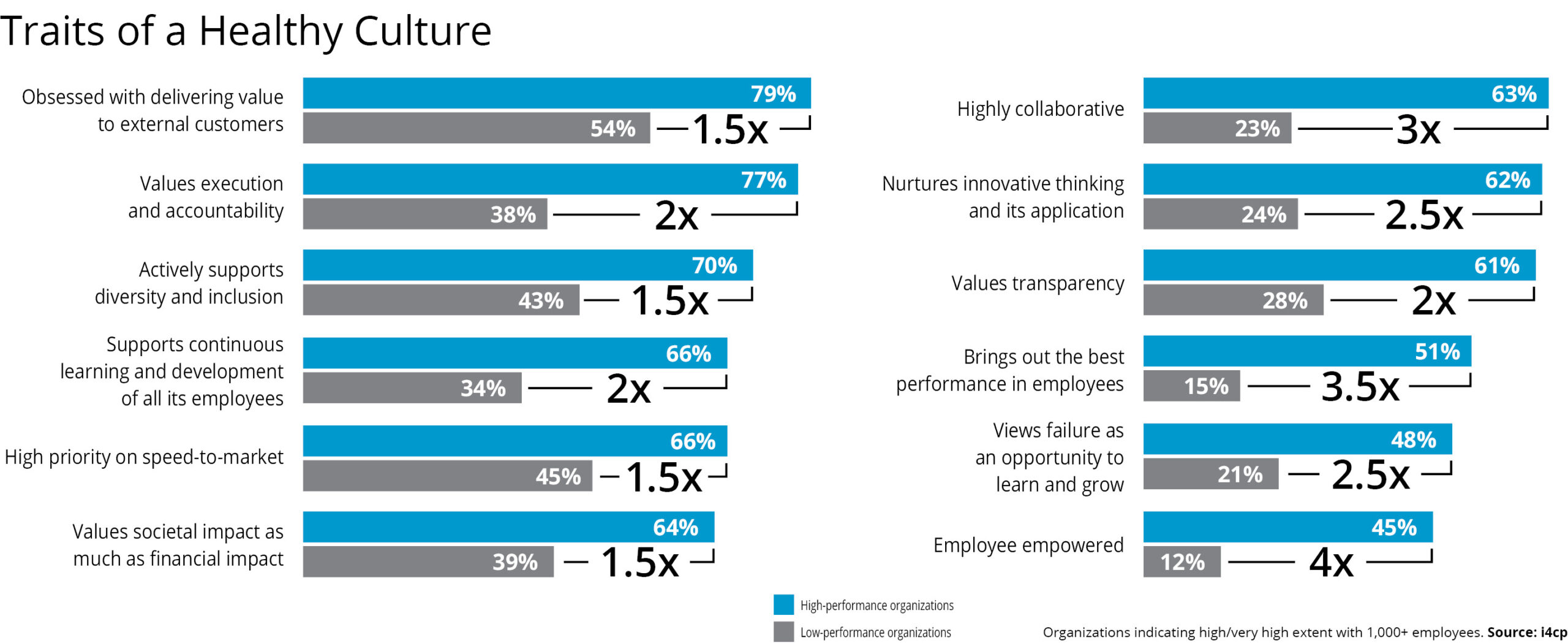Leadership Actions to Renovate Your Culture
Only 15% of organizations succeed in their attempts to improve company culture. Cultural transformations often struggle to get off the ground.
And yet organizational culture is a critical success factor to nearly everything. That’s why I have written about and studied it for decades.
Kevin Oakes is the head of one of the world’s leading HR research firms, the Institute for Corporate Productivity (i4cp). His book CULTURE RENOVATION: 18 Leadership Actions to Build an Unshakeable Company contains Kevin’s extensive experience and research into turning cultures into agile, innovative, and resilient powerhouses. I reached out to talk with him about his book.
What is the Kevin Oakes definition of culture?
This might not be completely obvious to readers of the book, but at no point do I define culture. This was very purposeful – I have read so many definitions of culture, and many tend to be very generic. My theory is that anyone who has worked in a company understands what culture is and didn’t need me to define it for them.
However, my co-founder Jay Jamrog often will use “Culture is felt by people because of what is done, condoned, rewarded, encouraged, penalized.” He and I both like the definition that Herb Kelleher, the former CEO of Southwest Airlines, once uttered: “Culture is what people do when no one is looking.”
You point out that only 15 percent of companies are successful in changing culture. Why is it that so many fail?
The obvious reason is that culture change is hard. My dad joined a large insurance company as the new CEO many years ago and told me “the culture was in the woodwork.” Culture gets very embedded over the years.
But a big reason why it fails is because many companies start the process all wrong. They assume they know the culture today vs. spending the time to listen and gauge employee sentiment. They leap into trying to change it before first analyzing who are the influencers and energizers in the workforce and aligning culture ambassadors throughout the organization. Often a new CEO alienates some in the workforce by applying blame for past failures vs. painting a vision for the future. They don’t set up measurements initially. They don’t spend time ensuring leaders “walk the talk” through training on leadership behaviors, and they don’t resolve naysayers and skeptics who can thwart change efforts…particularly at senior levels.
A lot of these steps are necessary before you begin the actual renovation. It’s like knocking down walls in a house renovation without having a blueprint of what you plan to do and an analysis of what will work. There’s a good chance you might knock down a load-bearing wall and ruin the whole thing.
When a new leader joins an organization, what are the best ways to assess and understand the existing culture?
The very first step of our 18 step blueprint is “Develop and Deploy a Comprehensive Listening Strategy.” This is so important…I often say the worst thing a senior team can do is lock themselves in a conference room and decide what the culture is today. They almost always get it wrong. Instead, you need to understand the culture through the eyes of the workforce at all levels, divisions, geographies, and departments.
A common way to do this is through frequent surveys and formal culture assessments. Based on our research, we developed a culture assessment so companies can benchmark themselves vs. other organizations as well as gain insight internally. Relying on the annual employee engagement survey is not a great proxy on employee sentiment. It’s one data point, but you need multiple, and frequent surveys to get a true picture. I’m a big fan of using Natural Language Processing, which is usually coupled with Artificial Intelligence, to allow employees to use their own words rather than just selecting from a list of pre-determined answers. The system does the hard work of categorizing that sentiment and can also be used to analyze external sentiment found on sites like Glassdoor or Indeed. While those comments can sometimes be overly caustic, it’s a data point that often provides insight. It’s also what job candidates are reading so it’s important to know what is being said.
What are some of the indicators of a healthy culture?
We studied this as part of our research and there are many things that high-performance organizations value vs. low-performance organizations. I won’t go through all of them but some that jump out to me:
- Obsessed with delivering value to customers
- Value execution and accountability
- Actively support diversity and inclusion
- Support continuous learning
- Value societal impact as much as financial impact
- Value transparency
- Encourage employee autonomy
Culture change starts at the top. You paint a powerful visual of Microsoft and I encourage everyone to read this chapter. Talk a little about the growth mindset and how it relates to culture.
Whenever you are changing culture, it helps to have simple yet powerful concepts to rally around and Microsoft – which I consider to be example 1A of how to renovate culture correctly – did this with growth mindset. They still reinforce this today and the simplest way to think about it is that intelligence and talent are not fixed traits. The true mark of success is one’s ability to learn. People who adopt a growth mindset try hard to understand why they failed, and tend to rebound from setbacks quickly, while those with fixed mindsets believe successes and failures are tied to innate traits and abilities.
Satya Nadella, Microsoft’s CEO, embraced this concept as the focal point of the company’s culture renovation primarily because Microsoft had a know-it-all problem. Previously people were rewarded and revered by how intelligent they were and how much knowledge they possessed, which was often wielded to retain and gain power. Satya changed the culture from a know-it-all culture to a learn-it-all culture, and throughout the company the importance of learning is stressed. No longer is there a concept of “knowledge is power.” Instead, knowledge-sharing is what gets recognized and rewarded.
There are always skeptics and naysayers and critics. What tips do you have in dealing with them during a cultural shift?
 This is the hardest step, but so important. The naysayers can quickly sabotage culture renovation efforts, particularly if they are in senior roles. There are a few stories from CEOs in the book that touch on having to move these culture change blockers aside, and often that meant out of the company. The best thing that can happen is to turn skeptics into champions, and you do that typically through examples and data. It’s important to have the senior leadership team all bought in to the culture change effort, and that someone isn’t secretly sabotaging because they feel their power base is threatened in some way. That’s why I say this is the hardest, because these skeptics can be hiding in plain sight, and constant communication, the listening strategies I mentioned earlier, and a science we outline in the book that looks at organizational networks are all methods to ferret out the skeptics – which is step number one – before ultimately dealing with them.
This is the hardest step, but so important. The naysayers can quickly sabotage culture renovation efforts, particularly if they are in senior roles. There are a few stories from CEOs in the book that touch on having to move these culture change blockers aside, and often that meant out of the company. The best thing that can happen is to turn skeptics into champions, and you do that typically through examples and data. It’s important to have the senior leadership team all bought in to the culture change effort, and that someone isn’t secretly sabotaging because they feel their power base is threatened in some way. That’s why I say this is the hardest, because these skeptics can be hiding in plain sight, and constant communication, the listening strategies I mentioned earlier, and a science we outline in the book that looks at organizational networks are all methods to ferret out the skeptics – which is step number one – before ultimately dealing with them.
Measuring culture change is always a challenge. How do you best measure and report it?
There are multiple measures companies use to gauge progress. Employee engagement and sentiment are common, but I really like Employee Net Promoter Score, or NPS, which follows the same logic as customer NPS. Would your workforce recommend this as a good place to work to others? For open roles, the number of employee referrals is also a good metric to track over time. But we look at many elements of the culture for trends, such as internal transfers, re-hires, hotline activity, EAP usage, unwanted attrition, and – critically important today – well-being.
It’s important for companies to measure their culture because many boards are now asking for this and expecting it to be part of the measures they see regularly. For public companies, the SEC just passed a new requirement around human capital measures, so we will see more of these measures showing up in annual reports and proxy statements.
Having worked with countless organizations and leaders, what are some of the most common mistakes leaders make when thinking about culture?
The most common is that it doesn’t impact your financial success. It has a direct correlation to how successful a company is, and culture success precedes business success…not the other way around. I’m a firm believer in this based on all the research we’ve done and it’s clear that having unhealthy culture elements can be very dangerous. Just ask Wells Fargo or Boeing.
Another fallacy is that culture can’t be changed. My co-founder Jay used to believe this in fact, and he’s now a convert. It not only can be changed, but it can be changed rather quickly if you follow the right steps as the examples in the book illustrate.
Another argument I often hear is that culture is made up of micro- or sub-cultures. That’s true – there are mini cultures all over – but if an organization has a powerful and healthy overall culture, those mini cultures typically have many of the same elements, and it’s the overall company culture that usually dictates actions, habits, mores, etc.
In short, culture matters. And today companies need to recognize the pandemic changed every single organization’s culture. Some of it was positive, and some of it wasn’t. I encourage companies to be proactive about their culture…don’t just let it happen. They can take control of the culture and turn it into whatever they envision as long as they take the right steps.
For more information, see CULTURE RENOVATION: 18 Leadership Actions to Build an Unshakeable Company.
Image Credit: Nolan Issac


